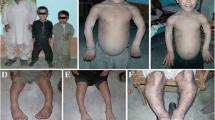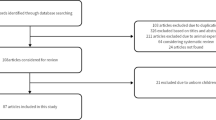Abstract
Recent DNA studies performed by several groups have detected mutations of the gene encoding fibroblast growth factor receptor 3 (FGFR3) in patients with achondroplasia-group disorders, including achondroplasia (ACH), hypochondroplasia (HCH), and thanatophoric dysplasia (TD). For this study, we analyzed theFGFR3 gene in 31 Japanese patients with typical ACH, four with HCH, three with a condition intermediate between ACH and HCH (ACH/HCH-intermediate), and one with TD. Of the 31 typical ACH patients, 29 showed a G1138 to A transition and the other two a G1138 to C transversion, both resulting in a common Gly380Arg substitution in the transmembrane domain of FGFR3. The one TD and the four HCH patients did not display any mutations in the transmembrane domain of FGFR3. Of the three ACH/HCH-intermediate cases, one patient showed the Gly380Arg substitution and one did not, and further analysis of the second patient revealed the presence of Asn540Lys substitution. The first patient was, therefore, genotypically diagnosed as ACH and the second as HCH. Peripheral blood leukocyte DNA analysis in the remaining ACH/HCH-intermediate patient indicated an unequal ratio of mutant to normal PCR products, possibly representing a somatic mosaic for the Gly380Arg mutation. Analysis of the common FGFR3 mutation thus appears to help in the molecular diagnosis of patients with achondroplasia-group disorders.
Similar content being viewed by others
References
Bellus GA, Hefferon TW, Ortiz de Luna RI, et al. Achondroplasia is defined by recurrent G380R mutations of FGFR3. Am J Hum Genet 1995;56:368–373.
Bellus GA, McIntosh I, Anne Smith E, et al. A recurrent mutation in the tyrosine kinase domain of fibroblast growth factor receptor 3 causes hypochondroplasia. Nat Genet 1995;10:357–359.
Gardner RJM. A new estimate of the achondroplasia mutation rate. Clin Genet 1977;11:31–38.
Ikegawa S, Fukushima Y, Isomura M, et al. Mutations of the fibroblast growth factor receptor-3 gene in one familial and six sporadic cases of achondroplasia in Japanese patients. Hum Genet 1995;96:309–311.
Langer LO, Baumann PA, Gorlin RJ. Achondroplasia. Am J Roentgenol 1967;100:12–26.
Maroteaux P, Lamy M. Achondroplasia in man and animals. Clin Orthop 1964;33:91–103.
Oberklaid F, Danks DM, Jensen F, et al. Achondroplasia and hypochondroplasia: Comments on frequency, mutation rate, and radiological features in skull and spine. J Med Genet 1979;16:140–146.
Orioli IM, Castilla EE, Barbosa-Neto JG. The birth prevalence rates for the skeletal dysplasias. J Med Genet 1986;23:328–332.
Rousseau F, Bonaventure J, Legeai-Mallet L, et al. Mutations in the gene encoding fibroblast growth factor receptor-3 in achondroplasia. Nature 1994;371:252–254.
Rousseau F, Bonaventure J, Hayden MR, et al. Not all hypochondroplasia families are linked to chromosome 4p16.3 (abstract). Am J Hum Genet 1994;55s:A202.
Rousseau F, Saugier P, Le Merrer M, et al. Stop codon FGFR3 mutations in thanatophoric dwarfism type 1. Nat Genet 1995;10:11–12.
Sambrook J, Fritsch EF, Maniatis T. Molecular cloning: A laboratory manual. 2nd ed. New York: Cold Spring Harbor Laboratory Press, 1989.
Shiang R, Thompson LM, Zhu Y-Z, et al. Mutations in the transmembrane domain of FGFR3 cause the most common genetic form of dwarfism, achondroplasia. Cell 1994;78:335–342.
Stoilov I, Kilpatrick MW, Tsipouras P A common FGFR3 gene mutation is present in achondroplasia but not in hypochondroplasia. Am J Med Genet 1995;55:127–133.
Stoll C, Dott B, Roth M-P, et al. Birth prevalence rates of skeletal dysplasias. Clin Genet 1989;35:88–92.
Superti-Furga A, Eich G, Bucher HU, et al. A glycine 375-to-cysteine substitution in the transmembrane, domain of the fibroblast growth factor receptor-3 in a newborn with achondroplasia. Eur J Pediatr 1995;154:215–219.
Tavormina PL, Shiang R, Thompson LM, et al. Thanatophoric dysplasia (types I and II) caused by distinct mutations in fibroblast growth factor receptor 3. Nat Genet 1995;9:321–328.
Walker BA, Murdoch JL, Mckusick VA, et al. Hypochondroplasia. Am J Dis Child 1971;122:95–104.
Wynne-Davies R, Walsh WK, Gormley J. Achondroplasia and hypochondroplasia: Clinical variation and spinal stenosis. J Bone Joint Surg Br 1981;63:508–515.
Author information
Authors and Affiliations
About this article
Cite this article
Matsui, Y., Kimura, T., Tsumaki, N. et al. A common FGFR3 mutation functions as a diagnostic marker for achondroplasia-group disorders in the Japanese population. J Orthop Sci 1, 130–135 (1996). https://doi.org/10.1007/BF02348804
Received:
Accepted:
Issue Date:
DOI: https://doi.org/10.1007/BF02348804




